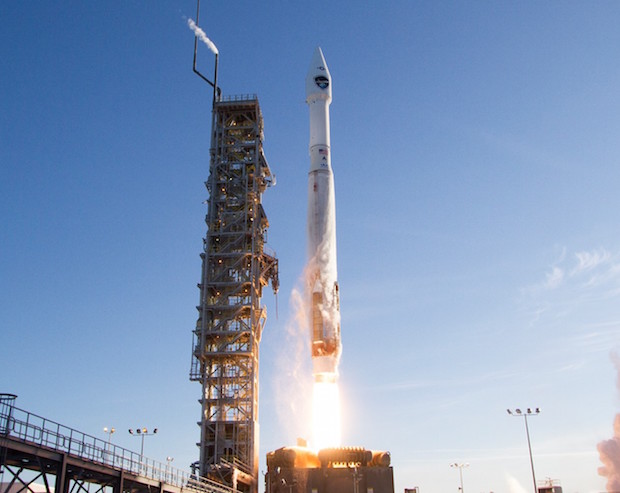
The U.S. Air Force has been unable to send commands to the service’s newest weather satellite for nearly a month, and engineers are trying to determine if the spacecraft can be salvaged, officials said last week.
The polar-orbiting Defense Meteorological Satellite Program Flight 19, or DMSP F19, spacecraft stopped responding to orders from the ground Feb. 11, the Air Force said in a March 3 press release.
“At this time, it is not known what caused the anomaly or if the satellite will be recovered, and the anomaly is under investigation,” the Air Force said. “There are no other known issues with the satellite.”
Designed for a five-year service life, DMSP F19 launched April 3, 2014, from California atop a United Launch Alliance Atlas 5 rocket. It is the newest in the Air Force’s series of DMSP weather observatories designed to help forecasters predict storms, clouds, fog and dust storms that could inhibit global military operations.
Satellite operators in Suitland, Maryland, are still receiving telemetry from DMSP F19 after the Feb. 11 anomaly, but it is unclear whether engineers can recover the satellite and continue its mission.
The Air Force said the DMSP F17 satellite, launched in November 2006, has been reassigned as the primary DMSP spacecraft, taking over for the crippled DMSP F19.
“There is no impact to the strategic weather mission, and the DMSP constellation remains able to support warfighter requirements through resilient systems and processes,” the Air Force statement said. “The constellation continues to provide weather and atmospheric data to users as it has for the past five decades.”
Officials generated a 30-day plan to reestablish command and control capability aboard DMSP F19. It will take “some time” to determine whether the DMSP F19 satellite can recovered, the Air Force said.

A detachment from the Air Force’s 50th Operations Group stationed at Schriever Air Force Base, Colorado, oversees the DMSP satellites in conjunction with NOAA’s satellite operations center in Suitland.
Made by Lockheed Martin, the DMSP satellites have not been immune to technical faults in recent years.
DMSP F19 only partially deployed its power-generating solar array after its April 2014 launch, but officials said the glitch did not affect its mission.
The DMSP F13 satellite launched in 1995 exploded in orbit last year, spreading debris fragments and adding to the growing space junk problem in low Earth orbit. Engineers blamed the disintegration on a battery fault, and investigators said other DMSP satellites are susceptible to the same flaw that could lead to further explosions in orbit.
The retired NOAA 16 civilian weather satellite in polar orbit with largely the same design as the DMSP spacecraft also broke apart in space last year, shedding more debris in orbit. It is not clear whether the Lockheed Martin-built NOAA 16 satellite used the same suspect battery design as the DMSP spacecraft.
Lockheed Martin completed construction of the DMSP satellites a decade ago, and the Air Force pulls the spacecraft from storage to launch as needed. For example, the DMSP F19 satellite was finished in 1998 and stored in a clean room at Lockheed Martin’s Sunnyvale, California, plant before technicians readied it for liftoff in 2014.
Engineers also added modernized components to the DMSP F19 satellite, such as upgraded star trackers and a digital gyroscope, in hopes of extending its life after launch.
Each DMSP satellite weighs about 2,700 pounds at liftoff and measures 14 feet tall. With its solar panel deployed in orbit, each satellite measures 25 feet long.
If DMSP F19 cannot be restored to service, the Air Force will have five DMSP weather satellites left in its constellation, all well beyond their design lifetimes.
One more DMSP satellite is built, but the Air Force plans to keep it on the ground and move on to a new generation of smaller meteorological spacecraft in the early 2020s.
Email the author.
Follow Stephen Clark on Twitter: @StephenClark1.



